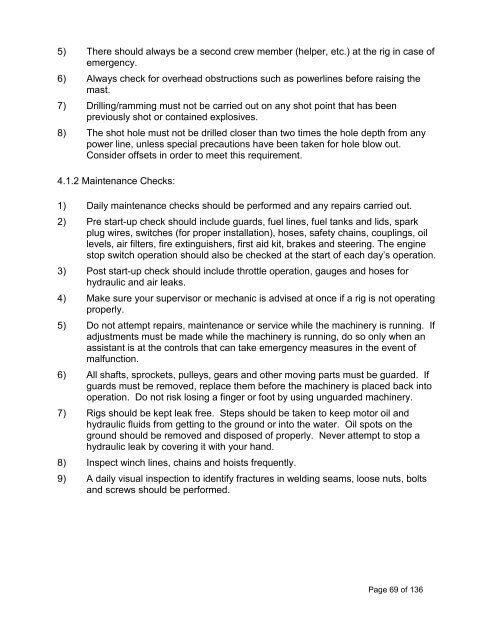IAGC LAND GEOPHYSICAL SAFETY MANUAL Edition 9 ... - CGISS
IAGC LAND GEOPHYSICAL SAFETY MANUAL Edition 9 ... - CGISS
IAGC LAND GEOPHYSICAL SAFETY MANUAL Edition 9 ... - CGISS
- No tags were found...
You also want an ePaper? Increase the reach of your titles
YUMPU automatically turns print PDFs into web optimized ePapers that Google loves.
5) There should always be a second crew member (helper, etc.) at the rig in case ofemergency.6) Always check for overhead obstructions such as powerlines before raising themast.7) Drilling/ramming must not be carried out on any shot point that has beenpreviously shot or contained explosives.8) The shot hole must not be drilled closer than two times the hole depth from anypower line, unless special precautions have been taken for hole blow out.Consider offsets in order to meet this requirement.4.1.2 Maintenance Checks:1) Daily maintenance checks should be performed and any repairs carried out.2) Pre start-up check should include guards, fuel lines, fuel tanks and lids, sparkplug wires, switches (for proper installation), hoses, safety chains, couplings, oillevels, air filters, fire extinguishers, first aid kit, brakes and steering. The enginestop switch operation should also be checked at the start of each day’s operation.3) Post start-up check should include throttle operation, gauges and hoses forhydraulic and air leaks.4) Make sure your supervisor or mechanic is advised at once if a rig is not operatingproperly.5) Do not attempt repairs, maintenance or service while the machinery is running. Ifadjustments must be made while the machinery is running, do so only when anassistant is at the controls that can take emergency measures in the event ofmalfunction.6) All shafts, sprockets, pulleys, gears and other moving parts must be guarded. Ifguards must be removed, replace them before the machinery is placed back intooperation. Do not risk losing a finger or foot by using unguarded machinery.7) Rigs should be kept leak free. Steps should be taken to keep motor oil andhydraulic fluids from getting to the ground or into the water. Oil spots on theground should be removed and disposed of properly. Never attempt to stop ahydraulic leak by covering it with your hand.8) Inspect winch lines, chains and hoists frequently.9) A daily visual inspection to identify fractures in welding seams, loose nuts, boltsand screws should be performed.Page 69 of 136
















